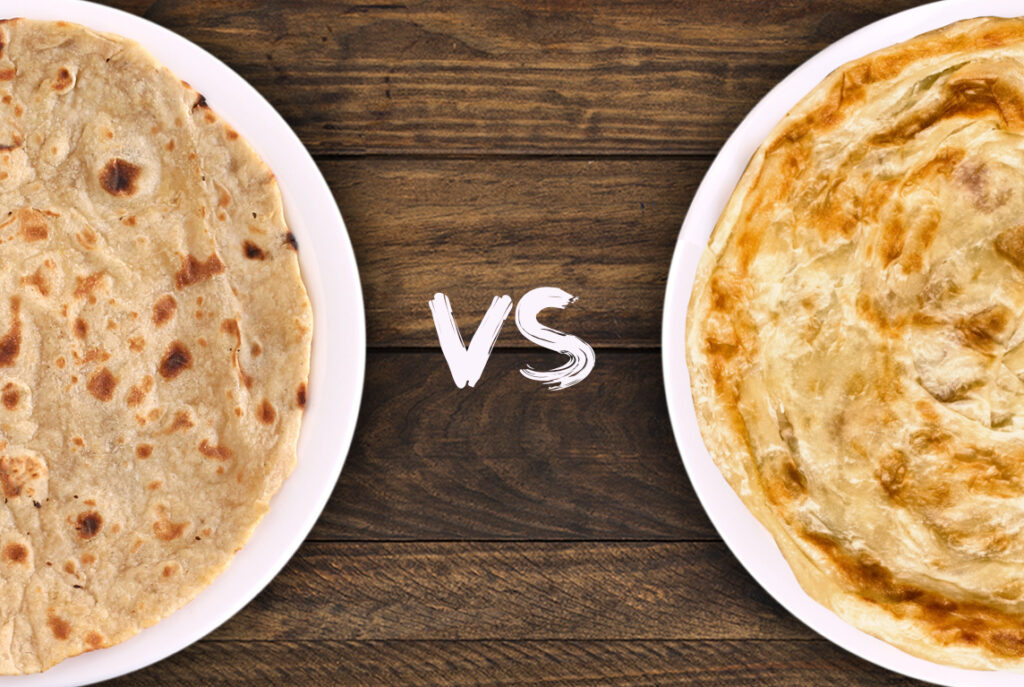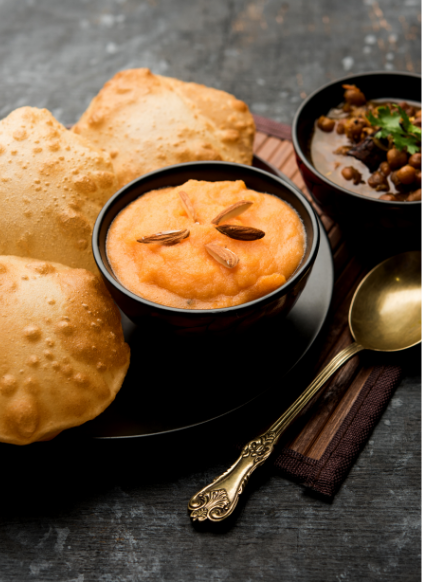Texture Wars: Roti vs Paratha – The Crispy-Smooth Conundrum
The argument between roti and paratha over Indian bread is never-ending. Roti vs paratha are both popular ingredients in Indian cooking, yet each has distinct features and textures that set it apart. In this article, we will investigate the crispy-smooth dilemma, the varied features of roti and paratha, and the numerous forms that tantalize taste buds across the country.
Table of Contents
What is Roti?
Roti, derived from the Sanskrit word “erotica,” is a traditional Indian unleavened flatbread made with whole wheat flour (atta). It is a staple in Indian households and is frequently eaten with curries, lentils, or veggies. Roti is a round bread cooked on a tawa (griddle) or directly over an open flame, producing soft, slightly puffed bread.
Types of Roti:
1. Naan:
Naan, a type of roti, is commonly linked with North Indian cuisine. It’s made with all-purpose flour (maida) and leavened with yeast or baking powder for a lighter, fluffier texture. Naan is traditionally baked in a tandoor, a clay oven, which imparts a smokey flavor.
2. Garlic naan
Another type of naan is Garlic naan, flavored with garlic and sprinkled with cilantro, which gives this already delicious bread an aromatic twist.
3. Roghni naan:
Roghni naan is a type of naan bread that is seasoned with butter and sesame seeds. It is a popular side dish in South Asian cuisine.
4. Keema naan:
Keema naan is a naan bread stuffed with minced meat and spices. It is often served as a main course in Pakistani and Indian restaurants but the good news is that you can have every kind of delicious naan at laree adda as well.
5. Sheermal
Sheermal, a sweetened saffron-infused flatbread, is another option with heavy gravies and kebabs.
What is Paratha?
In contrast, paratha is a layered, flaky bread prepared from whole wheat flour. It’s a popular breakfast or hearty lunch option, often packed with different contents and served with yogurt, pickles, or chutneys. Ghee or oil is used for cooking parathas, giving them a crispy and golden texture.
Types of Paratha:
1. Aloo Paratha:
Many people enjoy aloo paratha, which is packed with seasoned mashed potatoes. The combination of a soft, savory potato filling wrapped in a crispy, buttery paratha is delectable. It is frequently served with a dollop of butter or yogurt and pickles or tangy chutneys.
2. Chicken Paratha:
Chicken paratha is a delicious option for meat lovers. Cooked minced chicken is combined with various aromatic spices before being packed into the paratha. The end product is a savory and fulfilling bread that can be eaten as a meal on its own.
3. Cheese Paratha:
Cheese paratha will delight your taste buds if you’re craving something decadent. This delectable version blends shredded cheese with spices and herbs, such as mozzarella or paneer. The cheese melts while the paratha cooks, producing a gooey and savory experience with each bite.
The Texture Wars:
The texture of roti and paratha is what distinguishes them. Because of its soft and malleable nature, roti gives a pleasant and comfortable experience. It’s perfect for scooping curries or eating with dals (lentils). On the other hand, the layered and crispy structure of paratha lends a wonderful crunch, making it ideal for pairing with various fillings or as a standalone dish.
The Verdict:
There is no obvious winner in the texture war between roti and paratha. Personal preferences and the accompanying meals eventually determine the choice. Roti is the way to go if you desire soft and versatile bread. On the other hand, Paratha is the answer if you want a pleasing crunch and the excitement of discovering tasty fillings.
Conclusion:
Both roti vs. paratha are popular bread in Indian cuisine, each with its distinct texture and flavor. Whether you favor roti’s smoothness or paratha’s crispy layers, they both have a place on the table. Experiment with different types of roti and paratha to taste the diverse flavors of India’s rich culinary heritage. So, whether you’re a roti or a paratha fan, there’s no disputing that these breads have a unique place in our hearts and provide a magical touch to every meal.







